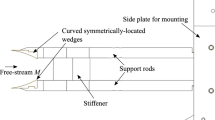Abstract
Curved shock theory is used to show that the flow behind attached shocks on doubly curved wedges can have either positive or negative post-shock pressure gradients depending on the freestream Mach number, the wedge angle and the two wedge curvatures. Given enough wedge length, the flow near the leading edge can choke to force the shock to detach from the wedge. This local choking can preempt both the maximum deflection and the sonic criteria for shock detachment. Analytical predictions for detachment by local choking are supported by CFD results.
























Similar content being viewed by others
Notes
Algebraic expressions for these coefficients are given in [3] where they have the following equivalents: \(a_{1} = J_{a}, a_{2} = J_{b}, b_{1} = K_{a}, b_{2} = K_{b}, d = I_{a}\).
An interesting variation would be to assume a linear decrease in Mach number instead of the square of the Mach number. In this case (9) is read, \(\hbox {d}M_{2}/{\mathrm{d}{s}} = - (1 - M_2)/L^{*}\). This equation gives a different value of \(L^{*}\) by at most a factor of 2.
The nature of local choking behind shocks is distinguished by the post-shock flow being either subsonic or supersonic. Hence the shocks are denoted as “subsonic” and “supersonic” in the two cases.
\(L^{*}\) is normalized by the URW radius of \(y_{1}=1\).
References
Guderley, K.G.: The Theory of Transonic Flow, Pergamon Press, 1962
Sudani, N., Saito, M., Karasawa, T., Noda, J., Tate, A., Watanabe, M.: Irregular effects on the transition from regular to Mach reflection of shock waves in wind tunnel flows. J. Fluid Mech. 459, 167–185 (2000). doi:10.1017/S0022112002007966
Mölder, S.: Curved shock theory. Shock Waves 26, 337–353 (2016). doi:10.1007/s00193-015-0589-9
Ames Research Staff: Equations, tables and charts for compressible flow. NACA Rep. 1135 (1953)
Liepmann, H.W., Roshko, A.: Elements of Gasdynamics. Wiley, New York (1956)
Owczarek, J.A.: Gas Dynamics. International Textbook Company, Scranton (1964)
Kantrowitz, A., Donaldson, C.D.: Preliminary investigation of supersonic diffusers. NACA Rep. ACR L5D20, Langley, VA (1945)
Masterix. Software Package. Ver. 3.40.03018, RBT Consultants, Toronto, ON, 2004–2015
Saito, T., Voinovich, P., Timofeev, E., Takayama, K.: Development and application of high-resolution adaptive numerical techniques in Shock Wave Research Center. In: Toro, E.F. (ed.) Godunov Methods: Theory and Applications, pp. 763–784. Kluwer Academic/Plenum Publishers, New York (2001)
Acknowledgements
Rabi Tahir generously provided the Masterix code and much essential support in its application. Evgeny Timofeev provided advice and effort in obtaining the CFD results using the Masterix code.
Author information
Authors and Affiliations
Corresponding author
Additional information
Communicated by B. W. Skews and E. Timofeev.
Rights and permissions
About this article
Cite this article
Mölder, S. Shock detachment from curved wedges. Shock Waves 27, 731–745 (2017). https://doi.org/10.1007/s00193-017-0714-z
Received:
Revised:
Accepted:
Published:
Issue Date:
DOI: https://doi.org/10.1007/s00193-017-0714-z




